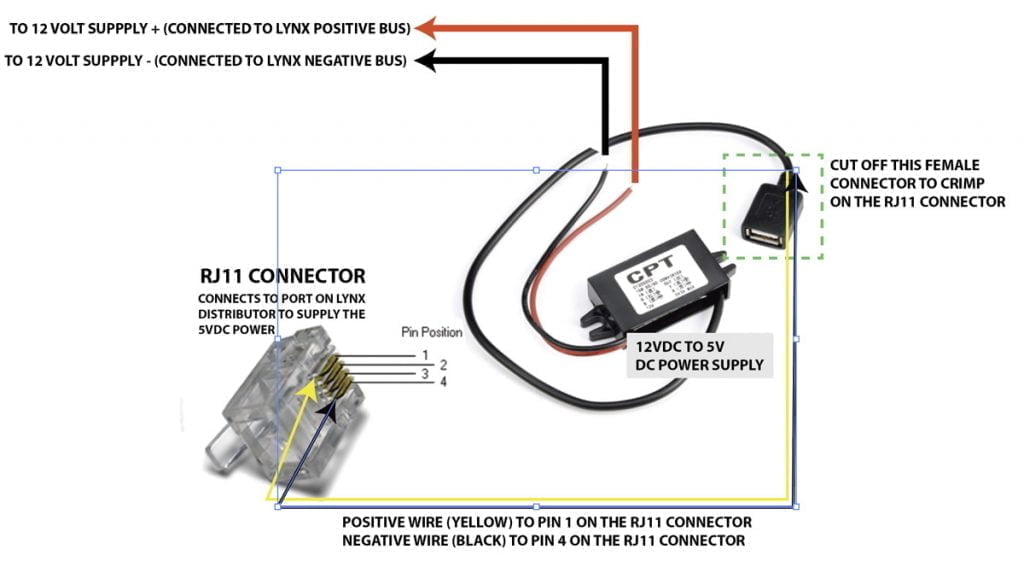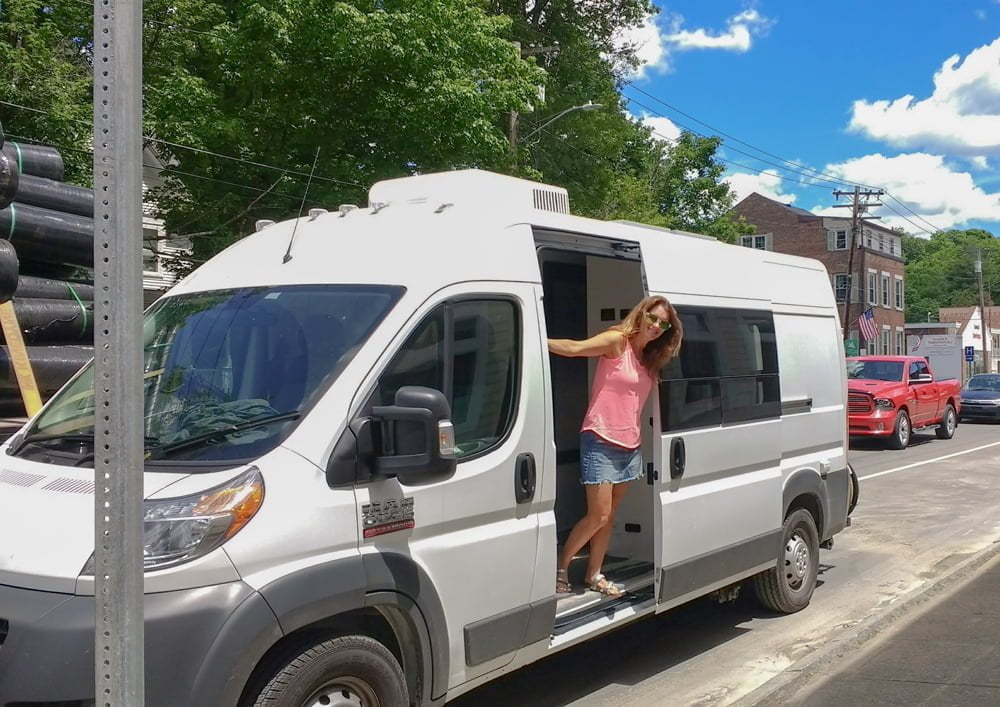Example DIY Camper Van Electrical System
This post was originally published in September 2020 and is great for a system up to about 300-400 amp hours of battery storage. We update it occasionally. We highly recommend starting at this page to get a orientation on how to plan and design a mobile power system. You can also reach out to us at support@vanlifeoutfitters.com or call us at 754-444-8704 x2.
This post includes a detailed wiring diagram and complete list of materials needed to put together a very reliable and robust electrical system for your camper van that is capable of extended off-grid adventures and powering just about anything you throw at it.
FREE Camper Van Power System Resources & Wiring Diagrams
If you're confused about your DIY camper van electrical or solar system, you've come to the right place. We have tons of resources including blog posts, videos and detailed example wiring diagrams (see below),If you're really stuck, we also offer consulting and design services. Our "choosing a system" page offers some additional advice and includes an example load calculation that you can use.Below are some of our example power systems for camper vans/RVs. The Victron-based systems all have a corresponding blog post, free detailed PDF example wiring diagram, and a corresponding best price product bundle. Ultimately, you'll probably customize your system to your particular needs and perhaps combine ideas from one or more of the example systems.
- A baseline camper van electrical system that uses lithium batteries with internal battery management systems (BMS) such as a Victron SuperPack, Battleborn, SOK, etc. This is our most affordable and simple system as well as the most DIY friendly.
- A more advanced camper van electrical system that uses Victron Smart lithium batteries with an external BMS and a Cerbo GX for monitoring. This system is a bit more complex and more costly, but adds features and allows for more battery storage in the same physical footprint. If you use the Victron Lynx Smart BMS you can upgrade to a dedicated secondary alternator with a Wakespeed regulator in the future.
- A super powerful (fast-charging) system that uses a dedicated secondary alternator. This system is the most expensive but also the most off-grid capable. We also have a 48-volt version of this system!
- We also have a power system accessories bundle that has all the circuit protection, shore power, distribution, and wiring you'll likely need.
Please consider purchasing your power system equipment from our store. Our bundles offer great pricing (yeah, better than Amazon), free shipping and you'll have access to expert support and you'll be supporting our ability to create more content!
Finally, there are a few things that we don't sell in our store (yet!) that you might need so we keep a list of these products in this Google Sheet of recommended camper van products.
Overview:
- 400 amp hours of lithium battery storage with built-in BMS
- 400 watts of rooftop solar
- 2400 watt inverter (up to 6000 watts surge) with 120 amp shore power charging capacity
- Integrated 12 volt DC and 120 volt AC load center
- 60 amps of alternator charging when driving/engine is running
- Optional pre-inverter shore power outlets
- Battery monitoring with Bluetooth
It’s super important to realize that there are hundreds of ways of skinning this cat. How awful. We won’t be skinning cats and neither should you. Anyway, the point is that this information should be considered a guide not gospel. You certainly could build out this system exactly as detailed but I would recommend considering your particular needs and then adjusting accordingly.
Also, wire lengths matter. This electrical diagram assumes that there is about a 20′ run from the vehicle battery back to the driver side wheel well where the “primary” electrical system is installed. What I mean by “primary” is most of the stuff you see on the wiring diagram – all the main parts but not the “branch circuits” that power the actual loads in the van like lights and fans, etc. It also assumes all those components are close together – not more than 5 (ish) feet of cable run between them. If your actual setup is different than this you need to adjust the wire gauge (AWG) accordingly. The Blue Sea Circuit Wizard is a great tool for understanding what gauge wire you need. You put in the load in amps, the length of the cable run and how long it will be running in minutes and it will tell you the correct gauge. I favor “over gauging” in general. Wire is pretty inexpensive relative to the other parts. In this wiring diagram I have also over gauged to keep it a bit more simple so that you don’t need so many types/gauges of wires and lugs and so on.
Speaking of wiring… you’ll probably use wire loom to protect your wires when you run them in areas they might be damaged by rubbing against stuff. So, let me introduce you to this “wire loom insertion tool“. It’s pretty much a game changer.
Why A 50 Amp Breaker?!
With most 2000 or 3000 watt inverters you would match the shore power’s 30 amp inlet on the output side. However, Victron Multiplus inverters have a unique feature -they will actually supplement the utility power coming in from the shore power plug with their inverted power – up to 3000 additional watts. So, if you manage to have enough stuff running in your van to exceed the 30 amp service from the shore power, the inverter would actually fill in the gap instead of tripping the shore power breaker. So, while this is not likely to happen unless you’re running some kind of crazy loads in your rig, it’s important to provide circuit protection and adequate wiring “just in case”. Therefore this wiring diagram calls for a 50 amp breaker downstream from the inverter with 6 AWG wire instead of a more “typical” 30 amp breaker with 10 AWG wire.
Inverter Wattage
If you look closely at the specs of the Victron Multiplus inverters they don’t actually support continuous 2000 or 3000 watts respectively. This isn’t important but it can be a bit confusing because of how they’re named.
The MultiPlus 12/3000/120 outputs 2400 watt continuous output at 77 degrees, 2200 watts at 104 degrees and surge up to 6000 watts.
The MultiPlus 12/2000/80 outputs 1600 watt continuous output at 77 degrees, 1450 watts at 104 degrees and surges up to 4000 watts.
Victron MultiPlus Inverter/Charger Configuation
Once you get your system all wired up you’ll need to configure/program the MultiPlus to, at minimum, work with the batteries you’ve chosen and maybe tweak a few of the other settings. We have another post on how to do that.
A Little Battery Update (June 2021)
In addition to the complexity, the other pain point around electrical systems is how expensive they are. In particular, the leading brands of lithium batteries such as the Victron SuperPack batteries we show in our example and other popular brands like Battleborn) are very expensive – about $1,000 per 100 amp hours. It’s a classic sort of “pay for what you get” scenario and there are good reasons to purchase the highest quality components. For example, the are excellent quality, designed to last for many years with 10 year (!) warranties. But, the truth is that not every van build needs the very best batteries and there are well-made alternatives that are just about half the price! In some cases, having more capacity (amp hours of stored energy) may be better than more longevity. You can ask yourself, do I want to run the stuff in my van twice as long for a few years or half as long for a decade?
Anyway, Will Prowse made an excellent video testing out well-built but lower cost lithium batteries that is worth checking out. One example is the SOK 206 amp hour battery that is currently selling on Amazon for $1,029.
Wiring Diagrams
The image below is for quick reference but I recommending downloading the PDF file (below) for much more detail and the ability to print/zoom in.
If you have AC loads that should ONLY be powered by shore (utility) power, (not inverted AC power), you can use the “AC out 2” connections on the MultiPlus inverter/charger which is only “live” when shore power is available. One good example of this would be an AC/DC refrigerator. Many of those will “default” to AC power when it’s available. If you wired up an outlet near your refrigerator that was powered by the inverter, the fridge would switch to that source of power anytime the inverter was on (inverting) which is less energy efficient that it continuing to run off the 12 volt DC power. If, instead you wire up that AC outlet that feeds the refrigerator, it will only run off the AC power when you have shore/utility power.
If You’re Using a Renogy DC-DC Charger Instead of the Victron Orion Units
Unlike some other battery-to-battery charging products that sense voltage and trigger the charging based on that, the Renogy DC to DC charger (or battery-to-battery charger) that I used requires you to connect up a 12 volt positive “signal wire” from the vehicle’s ignition switch so that it only charges from the van (vehicle) battery when the ignition is turned on. Without this ignition trigger on this unit or the voltage sensing on others, the battery-to-battery charger could easily drain the van battery since the battery-to-battery charger would be pulling current without the alternator providing a charge.
After some research I discovered that some Promaster vans (2016 or newer I think) have a “Upfitter Connector” on the passenger side “pillar” which is that area just behind the passenger seat where the seat belt connects to the van wall. If you remove the black plastic trim at the bottom of this “pillar” you’ll see a white multi-pin connector (photo below). This is the “upfitter connection” that provides a variety of connection points for the Promaster in one spot. This PDF file (Promaster Upfitter Connector Diagram PDF) details this connector including what each pin on the connector is/does. Turns out that pin #13 is an “ignition feed” that has 12 volt positive when the ignition switch is on. So, I used this to be the “trigger” for the Renogy DC to DC charger.
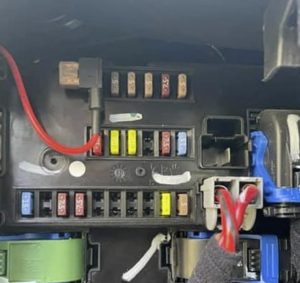 Note: if you have an older Promaster that does not have this upfitter connection you can consider splicing into the cab area cigarette lighter wiring as detailed in this post. Another option is to use a “tap a fuse” type splitter on fuse #31 in the Promaster fuse block (below the steering wheel). The photo shows this location. These things allow you to maintain the fusing for the original circuit but tap into that fuse location for a second circuit. In this case you’d use a 5 amp fuse for each.
Note: if you have an older Promaster that does not have this upfitter connection you can consider splicing into the cab area cigarette lighter wiring as detailed in this post. Another option is to use a “tap a fuse” type splitter on fuse #31 in the Promaster fuse block (below the steering wheel). The photo shows this location. These things allow you to maintain the fusing for the original circuit but tap into that fuse location for a second circuit. In this case you’d use a 5 amp fuse for each.
Close Up Shot of Promaster Van Upfitter Connector with Pin #13 Connected:
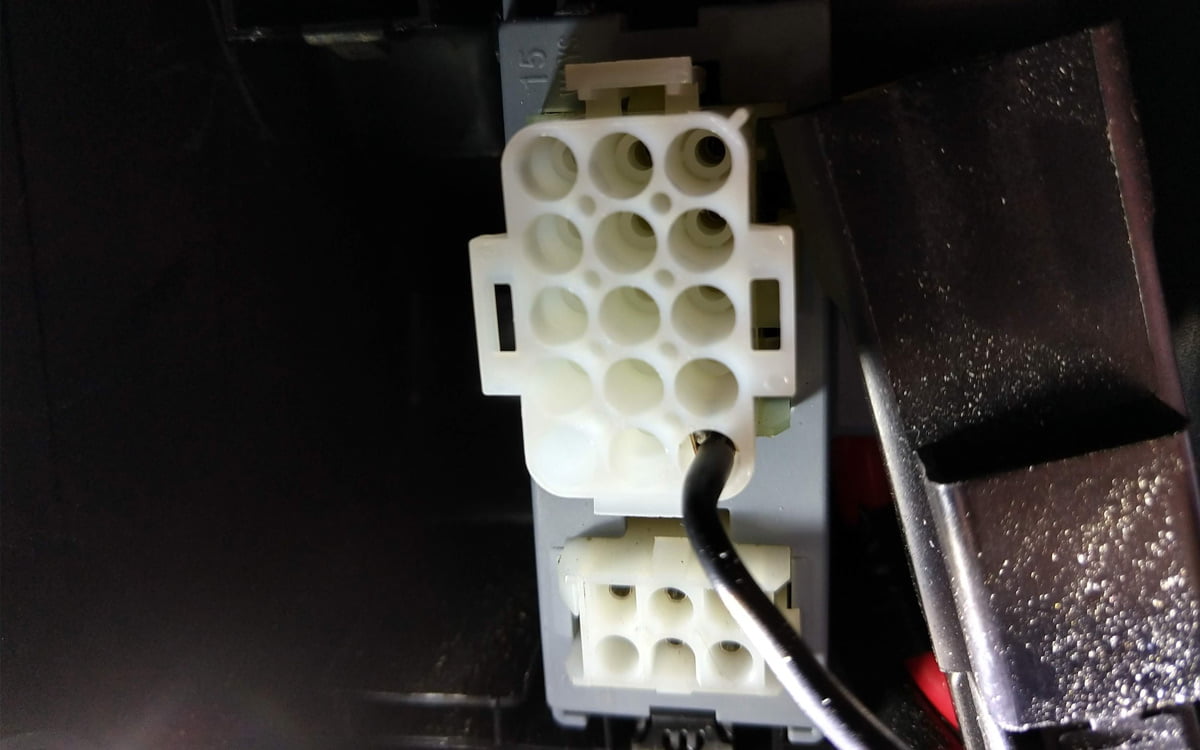
In order to do this, I had to order the correct, “male” version of this connector (part number 1-480710-0) as well as the “pin” itself (part number 350218-1). The way this works is that you solder the correct wire to an empty pin and then insert that pin into the correct position on the connector thus allowing you to access and wire up a variety of things to this upfitter connector. These parts are pretty inexpensive so I bought a few with the expectation that I’d destroy a few figuring out how this all works. I’m glad I did because I did indeed destroy a few experimenting. Ultimately, it’s not difficult but finding the right parts and how they fit together took some time. So hopefully this saves you that time!
Soldering the Wire to the Pin:
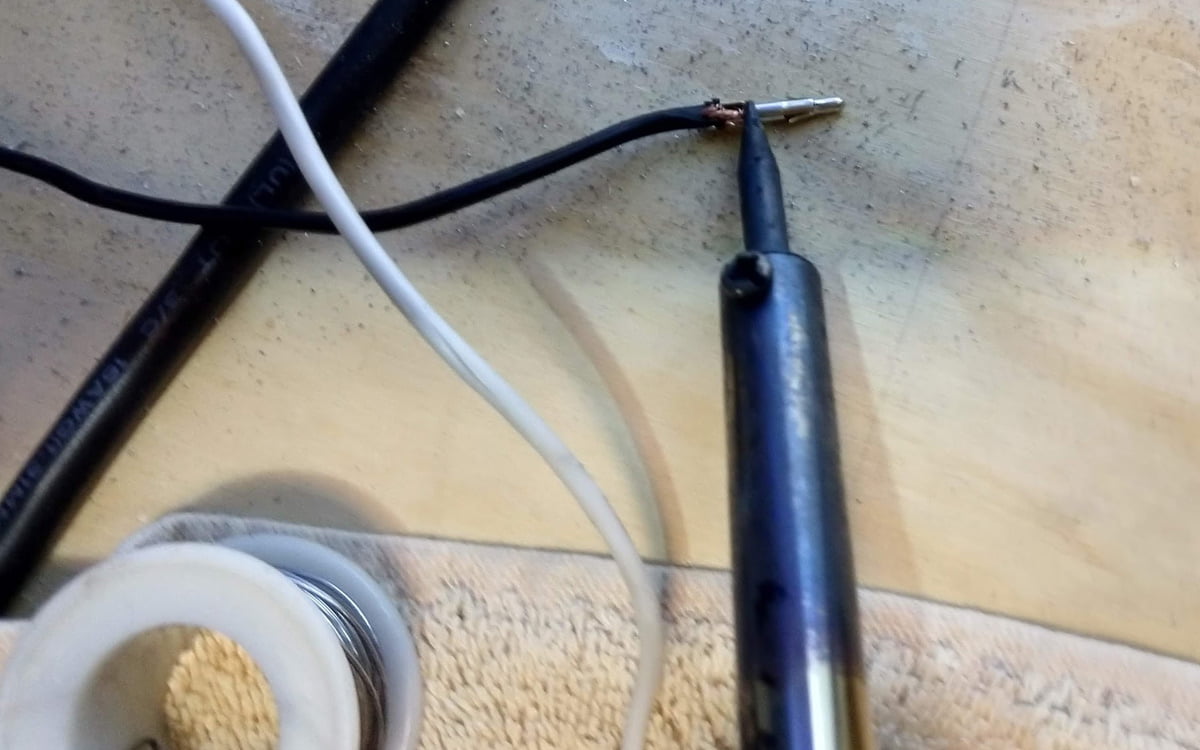
The wire coming out of pin #13 on the Upfitter Connector runs back to the rear passenger side wheel well where the primary electrical system is installed and is connected to the Renogy DC to DC charger on a terminal labeled “D+”. Below is a photo of this connection:
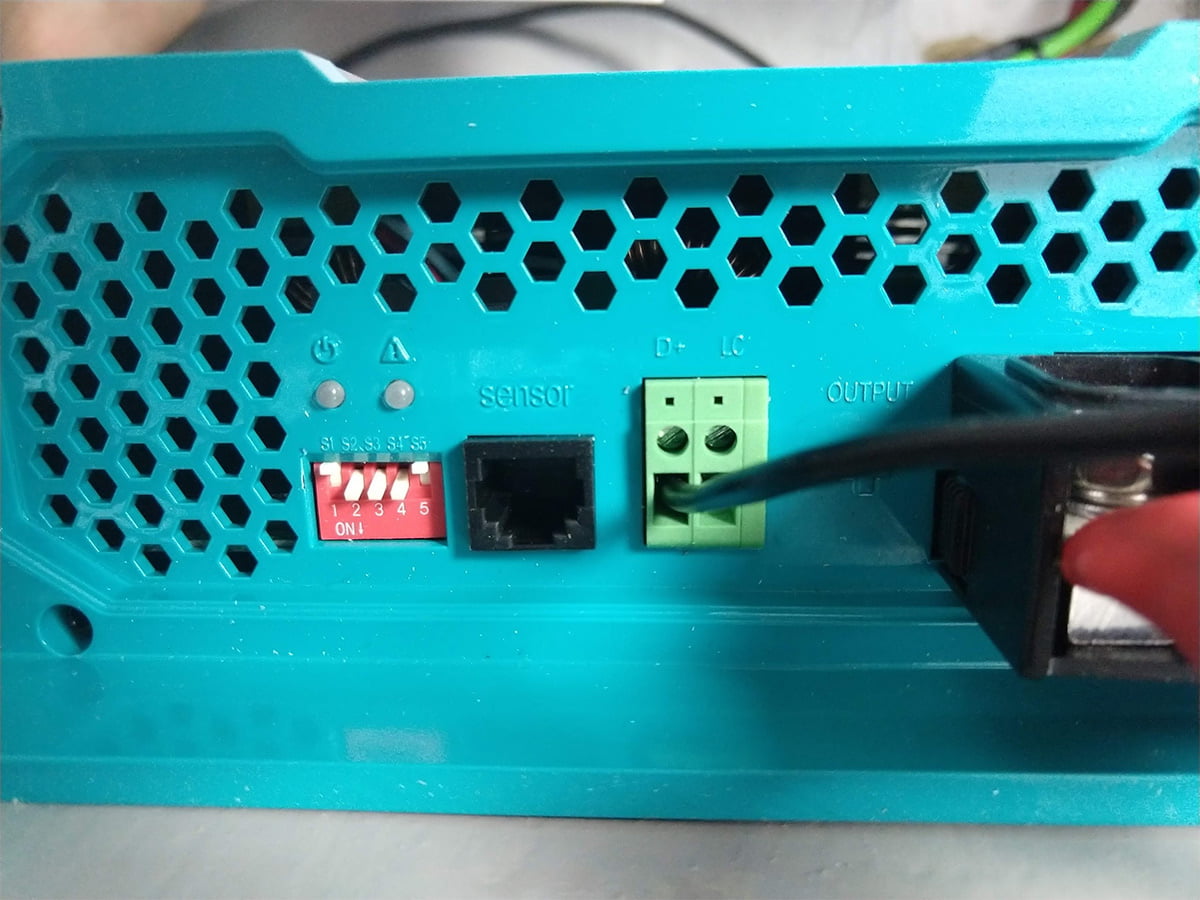
Next I had to configure the Renogy DC to DC charger to correctly charge the lithium batteries using the DIP switches pictured above. The manual for this Renogy DC to DC charger is really bad and the section on setting up the DIP switches is complete gibberish. I gave up on it pretty quickly and called into Renogy support. The correct DIP switch settings for charging lithium batteries with the Renogy DC to DC charger is:
- Switch #1: Off
- Switch #2: On
- Switch #3: On
- Switch #4: On
- Switch #5: Off
Turning On The LED Lights On The Lynx Distributor
There are LED lights on the Lynx Distributor that indicate if each of the circuits is live (the fuse isn’t blown). They light up green when it’s good and red when it’s not. These lights are normally powered when the Lynx Distributor is paired up with the Victron Lynx Shunt but you don’t need that if you use the “better-for-vanlife” (my opinion) BMV-712 battery monitor (listed above) which has it’s own shunt for monitoring.
So, if you don’t want to buy that hardware but do want the fancy lights, you can “hack” the lights with a 12 volt DC to 5 volt DC converter and an RJ11 “phone style” connector. This will provide the 5 volt power the LED lights need to fire up. Below is an illustration on how you’d do this – at your own risk, of course.
